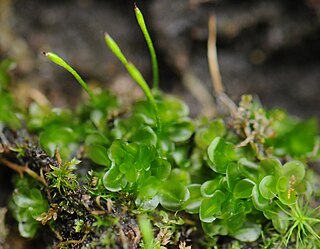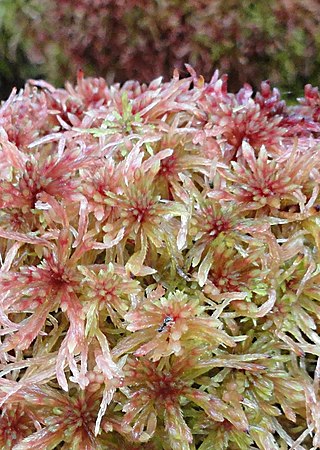
The Marchantiophyta are a division of non-vascular land plants commonly referred to as hepatics or liverworts. Like mosses and hornworts, they have a gametophyte-dominant life cycle, in which cells of the plant carry only a single set of genetic information. The division name was derived from the genus name Marchantia, named by French botanist Jean Marchant after his father.
Rhytidiadelphus triquetrus, the big shaggy-moss or rough goose neck moss, is a species of moss in the family Hylocomiaceae. It is often the dominating moss species in moderately rich forest habitats in the boreal regions and the Pacific Northwest. Because of its fuzzy appearance and tail-like shape it is also called the 'electrified cat's tail moss'. Not to be confused with square goose-necked moss, Rhytidiadelphus squarrosus.

Bryology is the branch of botany concerned with the scientific study of bryophytes. Bryologists are people who have an active interest in observing, recording, classifying or researching bryophytes. The field is often studied along with lichenology due to the similar appearance and ecological niche of the two organisms, even though bryophytes and lichens are not classified in the same kingdom.

Helodium blandowii, also known as Blandow's helodium moss, Blandow's tamarisk-moss, Blandow's bogmoss, and Blandow's feathermoss, is a common moss species in Europe. It is also found in North America, Central Asia and Greenland. It is considered rare plant in the Western U.S., including Oregon and California. It occurs all around the northern hemisphere in higher latitudes, and in some places is not as rare as in the Western U.S.

Oedipodium is the only genus of moss in the family Oedipodiaceae. It contains the single species Oedipodium griffithianum, the gouty-moss or Griffith's oedipodium moss. This species is distributed in cooler climates of Eurasia, as well as from Alaska, Washington state, British Columbia, Yukon, Greenland, Newfoundland, Tierra del Fuego and the Falkland Islands.

Hylocomium splendens, commonly known as glittering woodmoss, splendid feather moss, stairstep moss, and mountain fern moss, is a perennial clonal moss with a widespread distribution in Northern Hemisphere boreal forests. It is commonly found in Europe, Russia, Alaska and Canada, where it is often the most abundant moss species. It also grows in the Arctic tundra and further south at higher elevations in, for example, northern California, western Sichuan, East Africa, Australia, New Zealand and the West Indies. In Scotland it is a characteristic species of the Caledonian Forest. Under the UK's national vegetation classification system, pinewood community W18 is named as "Pinus sylvestris-Hylocomium splendens woodland", indicating its significance in this ecosystem.
Marsupella arctica, commonly known as Arctic rustwort, is a species of liverwort found in the Northern Hemisphere. It is present in Alaska and Greenland and has a European distribution confined to Scotland and Svalbard. The Scottish population was first discovered in 1989 and is restricted to two sites in the Cairngorm mountains - the Lairig Ghru and Beinn a' Bhùird.

Plagiomnium medium, commonly known as Alpine thyme-moss or intermediate plagiomnium moss, is a moss found in montane habitats in the Northern Hemisphere.

Hypnum cupressiforme, the cypress-leaved plaitmoss or hypnum moss, is a common and widespread species of moss belonging to the genus Hypnum. It is found in all continents except Antarctica and occurs in a wide variety of habitats and climatic zones. It typically grows on tree trunks, logs, walls, rocks and other surfaces. It prefers acidic environments and is fairly tolerant of pollution. It was formerly used as a filling for pillows and mattresses; the association with sleep is the origin of the genus name Hypnum.

Sphagnum russowii, Russow's sphagnum or Russow's bogmoss, is a species of peat moss with a Holarctic distribution.

Funaria hygrometrica, the bonfire moss or common cord-moss, is a type of water moss which grows on shady, moist soil. It can also be found on moist walls and the crevices of rocks and places where recent fires have taken place. It has been reported to grow in Niagara Cave, an artificially illuminated cave devoid of natural light. Under such conditions, its growth form changes so that the internodes lengthen and the leaves become longer and narrower.

Rhytidiadelphus squarrosus is a species of moss known as springy turf-moss in the United Kingdom, and square goose neck moss in the United States. It is widespread in Eurasia and North America, and has been introduced to the Southern Hemisphere. It has broad ecological tolerances, and is usually found in man-made habitats such as lawns and golf courses. It is most closely related to R. subpinnatus, with which it is often confused.
Silene taimyrensis, or Taimyr catchfly, is a herbaceous perennial in the family Caryophyllaceae. It is native to the Yukon and British Columbia in Canada and to Alaska. It is found to an elevation of a 1500 meters, growing in exposed subalpine to alpine locations with poor, rocky to sandy soils. It grows to a height of 40 cm in its native habitat and to twice that height as a garden plant; it has small, white to light pink flowers that grow in terminal clusters. S. taimyrensis is known in the fossil record from the Late Pleistocene.

Anomobryum julaceum, the slender silver-moss, is a species of bryophyte native to all continents except South America and Antarctica. A. julaceum is found widespread in the temperate regions of the Northern and Southern Hemispheres. Its capsules mature beginning in late fall and through the spring. It is most commonly found in wet crevices and on sandstone cliffs. Additional micro-habitats include tussock tundra with seeps and late snow melt areas and on granitic outcrops. In eastern North America it appears to be restricted to acid habitats, in the wet crevices of sandstone cliffs or other seepy niches. Overall, A. julaceum resembles species of the genus Pohlia, and its leaves are similar to those of Bryum argenteum; it can only be separated from Pohlia and Bryum using a microscope. Anomobryum julaceum can be distinguished from Bryum argenteum by its strongly julaceous, shiny leaves.
The British Bryological Society is an academic society dedicated to bryology, which encourages the study of bryophytes. It publishes the peer-reviewed Journal of Bryology.

Symphyotrichum falcatum is a species of flowering plant in the family Asteraceae. Commonly called white prairie aster and western heath aster, it is native to a widespread area of central and western North America.

Mnium stellare, the starry thyme-moss or stellar calcareous moss, is a moss species in the genus Mnium.
Tetrodontium repandum, the small four-tooth moss, is a moss in the family Tetraphidaceae. It is one of only two recognized species in the genus Tetrodontium, and is native to subalpine regions of the Northern Hemisphere. It has been reported from Alaska, British Columbia, Washington state, Japan, and Europe.

Marchesinia mackaii, or MacKay's pouncewort, is a species of leafy liverwort.

Noris Salazar Allen is a bryologist from Panama, who is Professor of Botany at the University of Panama and an associate researcher at the Smithsonian Tropical Research Institute. Salazar Allen was the first Panamanian to research bryophytes, and was instrumental in expanding the University of Panama's bryological collection to 10,000 specimens. In 2013 she received the Riclef Grolle Award for Excellence in Bryodiversity Research from the International Association of Bryologists.















